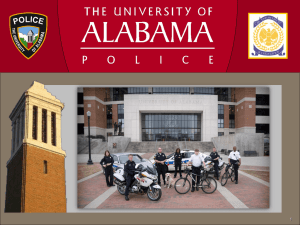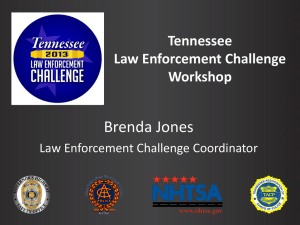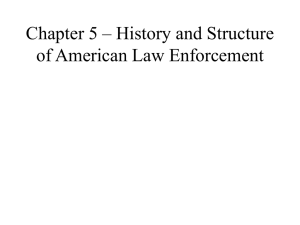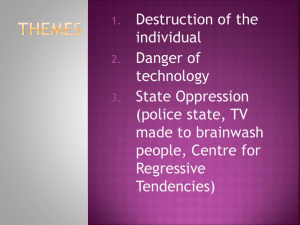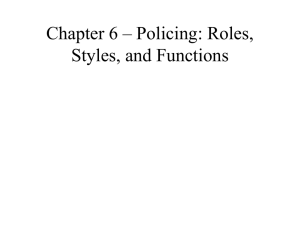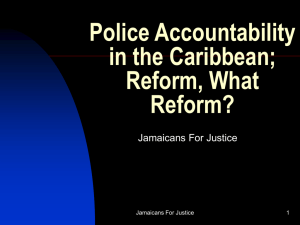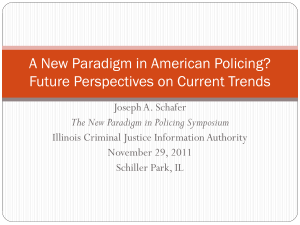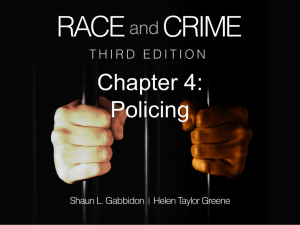History of Law Enforcement - Humble Independent School District
advertisement
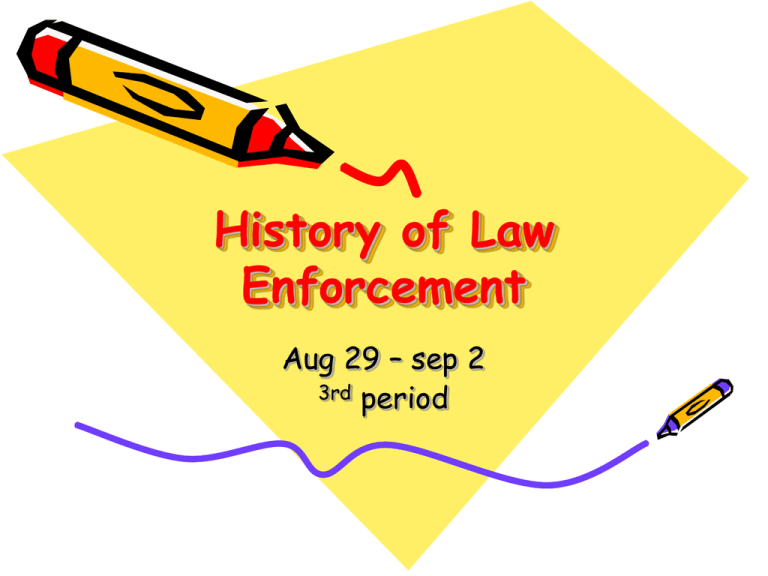
History of Law Enforcement Aug 29 – sep 2 3rd period Weekly Warm Up • • • • Inquirers They develop their natural curiosity. They acquire the skills necessary to conduct inquiry and research and show independence in learning. They actively enjoy learning and this love of learning will be sustained throughout their lives. Answer in 4 or more sentences for the week: – Are you an inquirer? How so? Rationale Modern law enforcement has been influenced by thousands of years and many civilizations. It is important for an officer to understand the history of his or her profession so they have an understanding of why things are the way they are. Objectives The student will be able to: 1. Identify the role of police in society. 2. Define terms associated with the lesson. 3. Discuss the origins and development of modern law enforcement. 4. Research the duties of law enforcement officers in various eras. 5. Create a presentation to teach others about the history of law enforcement. The role of police in a democratic society A. The police are entrusted to serve and protect. B. Law enforcement officers are the citizens’ most common and direct contact with the government. C. Law enforcement dates back to the earliest human civilizations. D. The Romans contributed the idea of districts or enforcement precincts. Law enforcement & Early Civilizations A. Extends back to the earliest civilizations B. Met a social need for promoting a group’s well-being C. Banishment was the most effective means of punishment. Camp guards of early civilization represent the first traces of law enforcement practices. D. First recorded police organization – 1340 B.C., in Egypt, under the reign of Pharoah Hur Moheb 1. River security force established to ensure security on the Nile 2. Responsible for preventing piracy, guarding commerce, and searching suspect ships E. Police is a derivative of the Greek work “Politeria” The portion of government that deals with protection of life and property. F. Roman contribution – during the reign of Emperor Augustus Caesar 1. Police were a special feature of the Roman government. 2. Various grades of officers 3. Seven divisions with 14 districts; districts represent the first city precincts English Roots A. American law enforcement concepts originated in England in 900 A.D. B. Justice was primarily a private matter based on revenge and retribution. C. Victims and/or family members would seek justice. D. King William – 1066 1. Frankpledge system 2. Tithing 3. Shires 4. Shire Reeve 5. Constables E. Winchester Statute – 1285 1. Night watch system 2. Selection of constables 3. Draft of volunteer citizens as watchmen F. Justice of Peace – 1326 1. Replaced Shire Reeve 2. Supervised law enforcement activities including crime investigation, securing criminals, and organizing the night watch system 3. The system lasted into the 1700’s. 4. Citizens were the police. 5. Law enforcement organization was local. G. Henry Fielding – 1700’s 1. The military was used for crime control. 2. Established the Bow Street Runners who apprehended criminals and recovered stolen property a) More effective than any other law enforcement of its day b) Paved the way for a more professional and efficient response to crime, and the apprehension of criminals H. Sir Robert Peel – 1829 1. Worked with the English Parliament to mandate a publicly funded police force under the London Metropolitan Police Act 2. Created uniformed police force known as “bobbies” or “peelers" 3. Peel’s 12 Principles of Policing 1. The police must be stable, efficient, and organized along military lines. 2. The police must be under government control. 3. The absence of crime will best prove the efficiency of police. 3. Peel’s 12 Principles of Policing 4. The distribution of crime news is essential. 5. The deployment of police strength, by both time and area, is essential. 6. No quality is more indispensable to a policeman than a perfect command of temper; a quiet, determined manner has more effect than a violent action. 3. Peel’s 12 Principles of Policing 7. Good appearance commands respect. 8. The securing and training of proper persons is the root of efficiency. 9. Public security demands that every police officer be given a number. 3. Peel’s 12 Principles of Policing 10. Police headquarters should be centrally located and easily accessible to the people. 11. Policemen should be hired on a probationary basis. 12. Police records are necessary to the correct distribution of police strength. Historical Eras of Law Enforcement C. Political Era (1840 to 1920) 1. The period when police agencies were established to provide a unified police force in the major American cities 2. The “Spoils” system; the metropolitan police in the 19th century were powerful, corrupt, poorly trained, unsupervised, and frequently abusive to the public they were to serve and protect. 3. The primary focus was on crime prevention and the maintenance of order through the foot patrol. D. Reform Era 1. Began in early part of the 20th century, as a result of the middle and upper class citizens’ concern with corruption 2. They wanted to get rid of political patronage and improve the efficiency of government, especially in law enforcement. 3. They called for professional police forces, to remove law enforcement from politics and to introduce modern technology to make law enforcement more efficient. D. Reform Era 4. One result of the Reform Era was the establishment of police administrative boards who were responsible for appointing police administrators and controlling police affairs. 5. These civilian review boards were established to reduce local political control over the police. 6. These review boards failed because the appointed leaders often lacked law enforcement knowledge. E. Professional Era (1920’s to the 1970’) 1. August Vollmer a) Chief of police in Berkley, California, was the most famous police reformer in the early part of the 20th century b) Instituted university training for police officers c) Helped to develop the School of Criminology at the University of California at Berkley. The school became the model for university-level criminal justice programs around the U.S. d) Believed that the police should be a professional force E. Professional Era (1920’s to the 1970’) e) The model of professional policing was developed from Vollmer’s six essential elements: (1) The police force should stay out of politics. (2) Members should be well trained, disciplined, and tightly organized. (3) Laws should be equally enforced. (4) The police should use technological developments. (5) Merit should be on the basis of personnel 2. O.W. Wilson a) The redirection of police from maintenance of order to one of crime control altered the nature of policing in America more than any of the other elements of the professional era. b) A student of Vollmer’s, advocated that law enforcement use motorized patrols, radio communication, and rapid response to aid effective crime fighting. c) Suggested the use of one-man patrols as the best way to deploy police personnel, and the importance of rotating beat assignments in order to fight police corruption F. Community Era (1970 to present) 1. Research findings indicate that the professional model was not working: a) Increasing the number of patrol officers in a neighborhood was found to have little effect on crime. b) Rapid response to calls for service does not greatly increase the arrest of criminals. c) It is difficult, if not impossible, to improve rates of solving crimes. G. Service to the community 1. In the 1970’s there was a movement away from the crime-fighting focus of law enforcement towards a greater emphasis on maintaining order and providing service to the community. 2. It was suggested that police officers get out of their patrol cars and spend more time on the street assisting citizens, while maintaining their crimefighting role. Activity #1 Timeline Project: Have students work in pairs to Research the “Top 10 Duties of Law Enforcement” for each of the following time periods: 1. Egyptian Civilization 2. Greek Civilization 3. Roman Civilization, 4. 900 to 1066 A.D., 5. 1066 to 1326 A.D., 6. 1326 to 1700 A.D., 7. 1700 to 1829 A.D., 8. 1829 to the present. Activity # 1 Continued Research Images • Then students locate royalty free or public domain images to illustrate the key points of research. • Students will use their research and images to create a pictorial timeline for display in the classroom. Activity # 2 1. The student will create their own 12 principles of policing, then compare and contrast them to Sir Robert Peel’s 12 principles.
